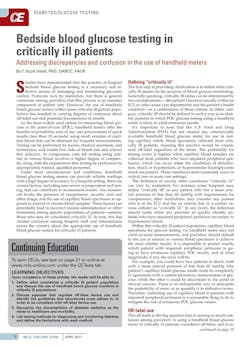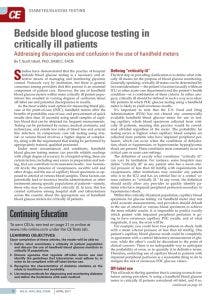Dear MLO Editor,
The article by Scott Isbell, PhD, DABCC, entitled “Bedside blood glucose testing in critically ill patients,” published in the April edition of MLO [2017;49(4):8-12] summarized some of the current issues related to testing capillary blood and the “Off-Label” use of blood glucose monitoring systems (BGMS) in critically ill patients. However, in our view the article did not completely nor adequately explain all the recent concerns about using BGMS in critically ill patient care settings and the reasons behind the publication of the new FDA guidance1 with specific critical care accuracy criteria and clearance requirements for manufacturers. More specifically, the article did not address the patient dangers associated with using blood glucose meters not cleared for use in critically ill patients, nor the regulatory risks to hospitals when they use a meter not cleared for critically ill patients in an “Off-Label” application.
The concern about the accuracy of BGMS used in critically ill patients is related to deaths and serious adverse events reported in the US FDA MAUDE database,2 as well as in peer-reviewed medical journals.3-5 These reports and publications represent the tip of the iceberg and are still being reported for certain glucose meters used routinely in hospital settings. The inaccuracy of many of the glucose meters currently used in critically ill patients is caused by factors often present in the whole blood matrix of acutely ill patients that specifically interfere with glucose measurements on those devices, which were originally designed for glucose self-monitoring.6,7 Additionally, inaccuracy is also a consequence of total analytical error (bias plus imprecision), which is related to the design of the device and measurement technology when compared to a definitive true glucose measurement.
While certain glucose meters may be acceptable for self-monitoring, when applied to a critically ill patient population the total error compounded by interference influences can greatly exceed 20 percent, resulting in adverse patient outcomes. Modelling and real patient studies have shown that total errors of >15 percent can result in a significant increase in one- and two-step insulin errors and an increased risk of hypoglycemia.8,9 Another potential inadequacy of glucose meters is the potential for missed diagnosis of hypoglycemia; it has been reported that with certain devices up to 50 percent of hypoglycemia events were missed.10 Consequently, the use of most glucose meters poses a significant patient safety risk in the diagnosis and monitoring of dysglycemia in critically ill patients.
As a result of this concern several entities, such as CLSI, FDA, SCCM, IFCC and ISICEM, published guidelines or recommendations with BGMS accuracy criteria aimed at reducing the risk to hospitalized patients and specifically patients in critical care settings. In 2014, in response to adverse events resulting in patient deaths, the New York State Department of Health required that all glucose meters be considered “Off-Label” for use in critically ill patients unless testing is performed by high complexity certified personnel.11 Case reports continue to be published noting adverse events due to inaccurate glucose meters used in critically ill patients.2
While Dr. Isbell’s article addressed some of the issues concerning glucose testing in critically ill patients, it did not go far enough in explaining that not all devices, independent of specimen type, are labelled for use in critically ill patient care settings. Based on FDA requirements, capillary whole blood is not acceptable with any BGMS and is considered “Off-Label” in critically ill patient care settings. As he stated, only one device has FDA 510(k) labelling specific for use in critically ill patient care settings with arterial and venous specimens.12 Consequently, all the other devices, including self-monitoring meters, are not labelled for this intended use and should not be used in these settings. When a device is not labelled for this use application, the device is formally deemed “Off-Label.”
The FDA now requires BGMS manufacturers to submit data to obtain labelling for use in critically ill patients inclusive of an extensive risk assessment using a range of clinical accuracy and risk assessment tools.1,12 Per the FDA’s guidance, proper risk assessment must include a wide range of critical patient conditions and extreme pathologies and an extensive range of intensive medications and therapeutic regimens.1 Additionally, BGMS should be compared to a true IDMS aligned laboratory reference method.1
Recent peer-reviewed publications have shown that the use of the labelled BGMS in adult and pediatric critical care patients has resulted in improved clinical outcomes.13-15 Care should be taken in the “Off-Label” use of BGMS in critically ill patient populations that have not been evaluated or cleared for this intended use application. Most devices, including self-monitoring meters, have not been properly evaluated for use in the critically ill and are now labelled “not intended” for use with critically ill patients. The FDA will hold manufacturers accountable for proper use application according to their product labelling and intended use. The CMS and accrediting agencies will require hospitals to comply with the intended use of their particular device. If the device is not labelled for use with critically ill, its use is “Off-Label.”
—Jeffrey A. DuBois, PhD, HCLD/CC(ABB), FACB
VP Medical and Scientific Affairs, Nova Biomedical
—Andrei Malic, PhD
Director Clinical Communications, Nova Biomedical
REFERENCES
- Department of Health and Human Services, Food and Drug Administration, Center for Devices and Radiological Health: Blood glucose monitoring test systems for prescription point-of-care use. Guidance for industry and Food and Drug Administration staff. Silver Spring, MD; FDA, 2016. http://www.fda.gov/downloads/medicaldevices/deviceregulationandguidance/guidancedocuments/ucm380325.pdf.
- Department of Health and Human Services, Food and Drug Administration. Manufacturer and user facility device experience database—(MAUDE). Silver Spring, MD: FDA, 1991-2015. http://www.fda.gov/MedicalDevices/DeviceRegulationandGuidance/PostmarketRequirements/ReportingAdverseEvents/ucm127891.htm.
- Sartor Z, Kesey J, Dissanaike S. The effects of intravenous vitamin C on point-of-care glucose monitoring. J Burn Care Res. 2015;36(1):50-56.
- Pillay TS, Turzyniecka MJ. Continuing danger of glucose point-of-care test devices in the neonatal setting [Letter to the editor].S Afr Med J. 2013;103(6):356-357.
- Jadhav P, Jadhav M. Fallaciously elevated glucose level by handheld glucometer in a patient with chronic kidney disease and hypoglycemic encephalopathy. International J Case Reports and Images. 2013;4(9):485-488.
- Denfeld QE, Goodell TT, Stafford KN, et al. Precision and accuracy: comparison of point-of-care and laboratory glucose concentrations in cardiothoracic surgery
patients. J Cardiovasc Nurs. 2011;26(6):512-518. - Dungan K, Chapman J, Braithwaite SS, et al. Glucose measurement: confounding issues in setting targets for inpatient management. Diabetes Care. 2007;30(2):403-409.
- Karon BS, Boyd JC, Klee GG. Empiric validation of simulation models for estimating glucose meter performance criteria for moderate levels of glycemic control. Diabetes Technol Ther. 2013;15(12):996-1003.
- Boyd JC, Bruns DE. Performance requirements for glucose assays in intensive care units [Editorial]. Clin Chem. 2014;60(12):1463-1465.
- Thomas F, Signal M, Harris DL, et al. CHYLD Study Group. Continuous glucose monitoring in newborn infants: how do errors in calibration measurements affect detected hypoglycemia? J Diabetes Sci Technol. 2014 8(3):543-50.
- New York State Department of Health. Off-Label Use of Glucose Meters. 13 Jan 2014.
- DuBois JA, Slingerland RJ, Fokkert M, et al. Bedside glucose monitoring—Is it safe? A new, regulatory-compliant risk assessment evaluation protocol in critically ill patient care settings. Crit Care Med. 2017;45(4):567-574.
- Tran NK, Godwin ZR, Steele AN, Wolf S, Palmieri T. Clinical impact of accurate point-of-care glucose monitoring for tight glycemic control in severely burned children. Pediatr Crit Care Med. 2016;17(9):e406-e412.
- Raizman JE, Shea J, Daly CH, et al. Clinical impact of improved point-of-care glucose monitoring in neonatal intensive care using Nova StatStrip: Evidence for improved accuracy, better sensitivity, and reduced test utilization. Clin Biochem. 2016;49(12):879-884.
- Karon BS, Meeusen JW Bryant SC. Impact of glucose meter error on glycemic variability and time in target range during glycemic control after cardiovascular surgery,
J Diabetes Sci Technol. 2016;10(2) 336–342.


